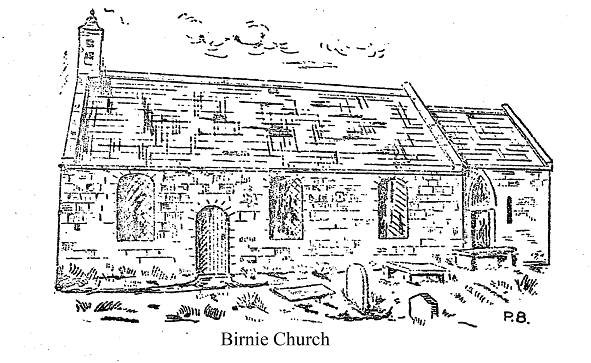|
Birnie and the Early
Bishopric of Moray (by Ian Keillar) Arising from the Field Club�s Weekend visit to Elgin, Ian has kindly provided this article as background. The date of the establishment of the bishopric is not definite. According to Watt1 the first bishop was Gregory, circa 1114 or 1120, while the see was directly subject to the pope until placed under the metropolitan authority of St.Andrews in 1472. Donaldson2, while not specific on Moray, mentions that in the 11th and early 12th centuries there was a plurality of bishop's sees in Scotland before the reign of David I. Barrow3, in writing of the church in Badenoch and Strathspey, does not name the first bishop of Moray. A much earlier historian, Bower4, notes that King Alexander in 1124 caused Sir Robert, prior of Scone, to be elected bishop of St. Andrews; but the mention of Moray is later, 1198, when Richard is recorded as bishop of Moray. As Duncan5 succinctly puts it 'The foundation of bishop's sees is also obscure." Thus while the date of the foundation is not precisely known it was very probably in the latter days of Alexander I (1107-1124). According to Cooper6 the early bishops were : Gregory 1107; William 1158-1161; Felix 1162-1171; Simon de Toenyl 171-1189 and Richard 1187-1203. These dates are slightly at variance with those given by Watt1, but by the time of Richard the authorities are reconciled. Shaw7 states, without quoting the evidence, that Tonei, one time monk of Melrose, is buried at Birnie. It is probable that there is an unknown bishop between Gregory and William and it may be that it was during this unknown bishop's reign that the existing Birnie kirk was constructed. Following Richard was Brice de Douglas8 1203-1222 who based himself at Kinneddar and early petitioned the pope that the cathedral of Moray, which had perambulated between Birnie, Kinneddar and Spynie, be fixed at Spynie. In response to Brice's petition, pope Innocent III complied with the bishop's request in a bull9 issued on 7th April 1207. A few year's later, Brice was again petitioning for the cathedral to be translated from Spynie to Elgin. The site at Birnie, deficient of its cathedra or bishop's chair, lapsed into obscurity but still retained its reputation, eventually degenerating into superstition, that it was a very special holy place. As the O.S.A.10 records "You have need to be prayed for thrice in the church of Birnie, that you may either end or mend." There was also the belief, retold by Ritchie11, that Birnie was so holy that it could even provide a sanctuary against the devil, while the minister at the time of writing the O.S.A. was instrumental in putting a stop to the superstitious practice of taking earth from the holy hillock to sprinkle on the graves of persons of evil repute. As with the date of the foundation of the bishopric so also unknown is the location of the bishop's palace. George Gordon12, parish minister for the major part of the 19th century, writes "About forty years ago, the foundations of an extensive building were dug up in the corner of a field, which had formerly the name of Castlehill" adding in a footnote teThe place now called Castlehill....(is a) new settlement." Cooper13 quotes Bishop Pocoke, writing in 1760, who tells "on the hill to the south of the church were some marks of foundations called the castle, which by tradition was the bishop's house."
But, what caused the church authorities to leave the airy uplands of Moray for the damp environs of Kinneddar and Spynie? Birnie was just too far from the security of Elgin and too near the Highlands to be safe from marauders. The place-name, Birnie is Gaelic14 and several of the surrounding names are also Gaelic, such as Cloddach, Shougle and Trochail. It can be assumed therefore that in the 12th century the population around Birnie was substantially Gaelic speaking Men of Moray. According to Bower15 the Men of Moray were early disturbers of the peace and killed King Malcolm I in AD954. 150 years later the Men of Moray were causing trouble for Alexander I who led an expedition against them and defeated their army somewhere on the west bank of the Spey. In 1130, in the time of king David, we hear that Angus, Earl of Moray, died fighting against the Scots. Troubles continued and for six years from 1181, Donald, son of William, son of Duncan II and a claimant to the Scottish kingdom, controlled Ross and Moray when, according to Duncan16, quoting Bainwell the annalist "The more recent kings of Scots (who) profess themselves to be rather Frenchmen in race, manners, language and outlook; and after reducing the Scots to utter servitude they admit only Frenchmen to their friendship and service." In this respect it is significant that the names of all the early bishops of Moray are French; there is not a Scottish (Gaelic) name among them. The Men of Moray, perhaps like the Men of Caithness, had a rough way of dealing with prelates and while the mutilation of the bishop of Caithness and his subsequent roasting took place after the assumed departure of the bishop from Birnie it is indicative of the resentment which the local population felt towards their imposed spiritual leaders. It is also significant that the bishops, once installed at Kinneddar, built a castle of great strength17. However, there were drawbacks at Kinneddar and the cathedral was soon flitted to Spynie and after a few years, in 1224, moved to the Church of the Holy Trinity, juxta Elgyn, where it has remained for over 775 years. References. |
